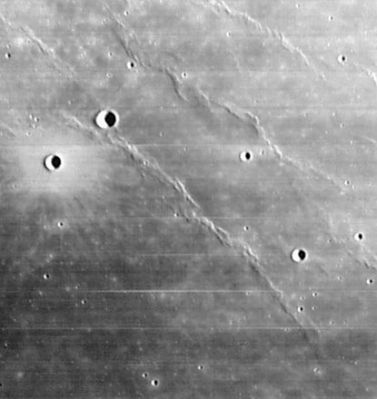Dorsum Scilla
Contents
Dorsum Scilla
|
Lat: 32.8°N, Long: 60.4°W, Length: 108 km, Height: km, [/R%C3%BCkl%208 Rükl: 8] |
Table of Contents
[#Dorsum Scilla Dorsum Scilla]
[#Dorsum Scilla-Images Images]
[#Dorsum Scilla-Maps Maps]
[#Dorsum Scilla-Description Description]
[#Dorsum Scilla-Description: Wikipedia Description: Wikipedia]
[#Dorsum Scilla-Additional Information Additional Information]
[#Dorsum Scilla-Nomenclature Nomenclature]
[#Dorsum Scilla-LPOD Articles LPOD Articles]
[#Dorsum Scilla-Bibliography Bibliography]

LOIV 163 H1 Dorsum Scilla is the southernmost of the three prominent ridges visible in this image (running up from the lower right corner). The crater with the bright halo is [/Lichtenberg Lichtenberg] B, and its slightly larger companion to the northeast is [/Naumann Naumann] G. Depending on what map one consults, Dorsum Scilla either terminates at Naumann G, or continues on beyond the upper left corner of the present image, possibly terminating at [/Naumann Naumann] (~ 100 km away, and out of image off to the northwest). The two equally prominent ridges, seen in image to the northeast of Dorsum Scilla, are unnamed.
Images
LPOD Photo Gallery Lunar Orbiter Images
Maps
([/LAC%20zone LAC zone] 23D4) LAC map Geologic map
Description
Description: Wikipedia
Additional Information
- The position and diameter given in the title line are the current values in the [/IAU%20Planetary%20Gazetteer IAU Planetary Gazetteer]. Most definitions seem to extend Dorsum Scilla farther to the north (see Nomenclature).
Nomenclature
- Named for Agostino Scilla (August 10, 1629 - May 31, 1700), an Italian painter, paleontologist, geologist, and pioneer in the study of fossils. He began to study fossils found in the hills of Sicily. In this work he argues for a scientific explanation for fossils, as opposed to them being of fantastic origin or a test of faith from God. He also correctly identified the supposedly magical objects that were called glossopetrae, or "tongue stones", as the teeth of sharks.
- Dorsum Scilla was among 120 names approved by the [/IAU IAU] in 1976 "as assigned" on the NASA [/LTO LTO] charts ([/IAU%20Transactions%20XVIB IAU Transactions XVIB]). However only the southernmost 14 km of it was actually charted on LTO-38B1. The name seems to have been extended northward on LM-38, and even further to the north on LAC-38 (540 kb PDF) of the [/USGS%20Digital%20Atlas USGS Digital Atlas]. With these extensions it would seem to have become a "dorsa" (a ridge system) rather than a "dorsum" (a single ridge). - JimMosher JimMosher
LPOD Articles
Bibliography
This page has been edited 1 times. The last modification was made by - tychocrater tychocrater on Jun 13, 2009 3:24 pm - afx3u2